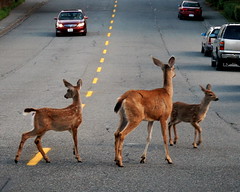 A hundred years ago, humans hunting for food had nearly wiped out local populations of deer, turkey and even squirrels in the Mid-Atlantic region. And humans protecting their livestock or hunting for trophies wiped out bear and wolf populations.
A hundred years ago, humans hunting for food had nearly wiped out local populations of deer, turkey and even squirrels in the Mid-Atlantic region. And humans protecting their livestock or hunting for trophies wiped out bear and wolf populations.
Deer were eventually reintroduced – and their populations exploded. While black bears have made a comeback, they’re too slow to hunt adult deer. Wolves are great deer hunters, but reintroduction efforts in the eastern half of the United States have had limited success. And deer hunting is restricted on private property & on federal parkland, where deer thrive dashing through backyards and parks.
Today WAMU reports on the disastrous results for both people & our environment:
As an ever-rising population of white-tailed deer have bumped up against their human neighbors in the D.C. area, the results haven’t been pretty. There were an estimated 88,000 deer-vehicle collisions in Virginia, Maryland, D.C., and Delaware last year.
But beyond the roads, experts say the deer are also having a major impact on forests, which are unable to replenish themselves to nurture the next generation due to the deer population’s eating habits.
Nationwide, those deer collisions result in 140 deaths and $3.8 billion in property damage every year. And it’s not as if overpopulation is great for the deer, which can face starvation and disease.
This isn’t a problem only in rural areas – Rock Creek Park is being stripped of plants below shoulder height. Even if deer populations came into balance today, it could take generations for trees to recover. As my friend Max points out, “And how about deer ticks? Since I work in Reston, I walk through approximately eleven billion deer ticks every day between the bus and the front door of my office.”
But the good news is that proper population management can deliver results right away. In Yellowstone National Park, a combination of hunting and wolf reintroduction have helped drive a rebirth – not just for trees, but for the birds, beaver, and dozens of other species that depend on a balanced ecosystem.
The bottom line is that unlimited, unchecked deer population growth isn’t good for anyone – not for deer, not for humans, and not for our ecosystems.
Cross-posted from The Green Miles



 Sign up for the Blue Virginia weekly newsletter
Sign up for the Blue Virginia weekly newsletter
![Rep. Eugene Vindman (D-VA07) Has Mostly Been Excellent So Far, But Being One of “35 House Democrats [Who] Joined Republicans Against a Major Climate Policy” Is Not Cool. At All.](https://bluevirginia.us/wp-content/uploads/2025/05/nytcalifornia-238x178.jpg)






